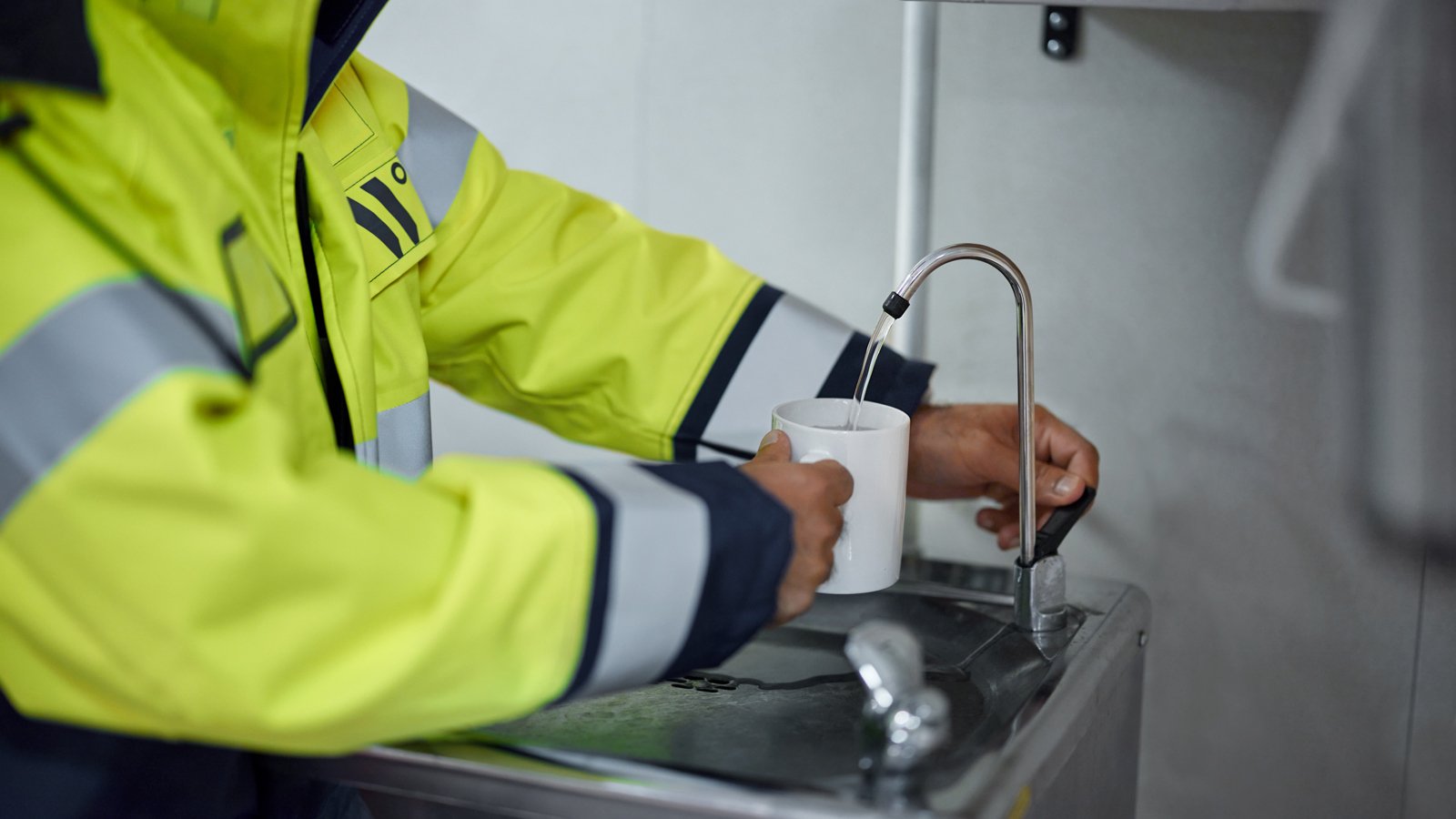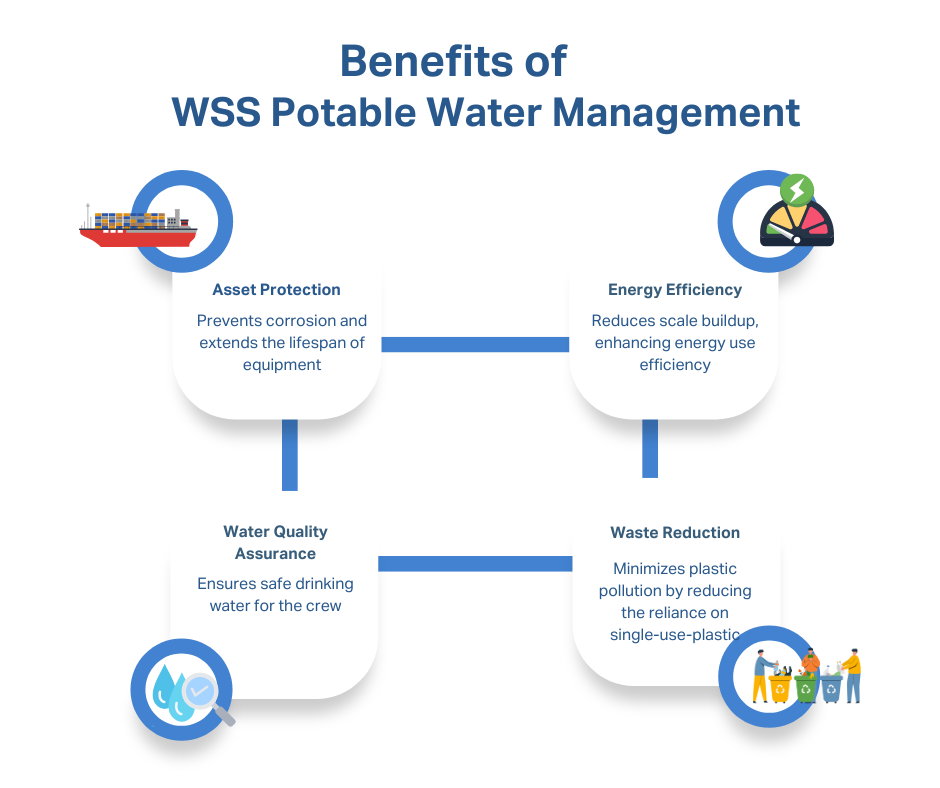Comprehensive guide to chemical treatment of water for vessels

Wilhelmsen insights
|
Ding Hou Han, Product Manager – Water Solutions

Ensuring the quality of potable water on ships is crucial for crew health and equipment integrity. Since the enforcement of the Maritime Labour Convention (MLC) 2006, there has been a significant improvement in potable water quality and assurance for onboard crew consumption. However, many crew members still rely on bottled water purchased from shore.
This article explores the reasons behind this practice and how to improve the adoption of onboard water treatment solutions.
How Water is Supplied to Vessels
Water supply to vessels can occur through two main methods:
- Bunkering: Ships can receive potable water from shore supply
- Shipboard Production: Ships can produce water onboard using thermal desalination (fresh water generators) or filtration (reverse osmosis systems). Typically, a ship can generate over 90% of its onboard water demand
Water Quality Risk Assessment
From a water quality risk assessment perspective, there are two major categories of risks:
- Biological Factors: Pathogens such as E. coli, Enterococci, and Legionella pose risks to human health.
- Chemical Factors: Heavy metals and other chemical contaminants can affect asset integrity, energy efficiency, pipeline corrosion, maintenance activities, health, and aesthetics.
Traditionally, ships have focused on addressing biological risks through onboard treatment, testing, and sending samples for shoreside lab testing. While this has significantly safeguarded crew health, the lack of focus on chemical parameters has created another area requiring similar attention. Chemical risks can impact asset integrity, energy efficiency, and lead to pipeline corrosion, increased maintenance activities, and health concerns.
Addressing Key Concerns in Water Production
At Wilhelmsen Ships Service, we address these concerns right from the water production journey.
Production Stage
- Seawater Intake: Traditionally, seawater is treated with a marine growth protection system (MGPS) to reduce marine fouling. As equipment ages or lacks maintenance, performance can drop. The addition of Nalfleet™ Bioguard Plus (778918) as marine fouling control greatly enhances the needed protection and minimizes marine foulant accumulation.
- Water Generation: Water is generated either through a Fresh Water Generator or a Reverse Osmosis System (RO). Common issues with these water generators include scaling. An effective dispersant and drinking water certified product can reduce scale buildup, extending equipment run length and reducing cleaning frequency. For Fresh Water Generators, we recommend Nalfleet™ Vaptreat (571364), and for RO systems, we recommend Nalfleet™ RO Scale Control (777716).
Distribution Stage
- Produced Fresh Water to Potable Water Tank: Fresh water stripped of minerals and alkalinity needed for corrosion control and remineralization becomes corrosive, affecting pipeline integrity and causing tank maintenance issues. To address deposition concerns in Potable Water Tanks, we recommend CORRBLOCK (launching in Q4 2024)
- Potable Water Post Remineralization and UV Sterilization: Remineralized water may still be corrosive. To prevent pipeline corrosion and aesthetic issues such as red/brownish water, we recommend our CORRSHIELD Product (launching in Q4 2024), a two-step approach to prevent corrosion product carryover and reduce pipeline corrosion
- Disinfection: According to WHO guidelines, maintaining a disinfection residual of 0.2 – 1.0 ppm free chlorine is essential for biological control in distribution. For this, we recommend the Sodium Hypochlorite Potable Grade (909001) drinking water certified disinfectant
- pH Balance: Effective pH control is vital for disinfection, with most disinfectants working best at pH < 8.5. For pH exceeding target values, we recommend Hydrochloric Acid 33-35% Potable Grade (773408), certified to NSF 60
Our Integrated Potable Water Management approach contributes to:
The holistic approach to implementing an integrated potable water management system addresses both biological and chemical risks, ensuring the health and safety of crew members while optimizing operational efficiency.
The future of shipboard water management lies in the adoption of these comprehensive strategies, leading to improved crew welfare, reduced operational costs, and enhanced environmental stewardship. As the maritime industry continues to evolve, prioritizing advanced water treatment solutions will become increasingly crucial for operational excellence and regulatory compliance.